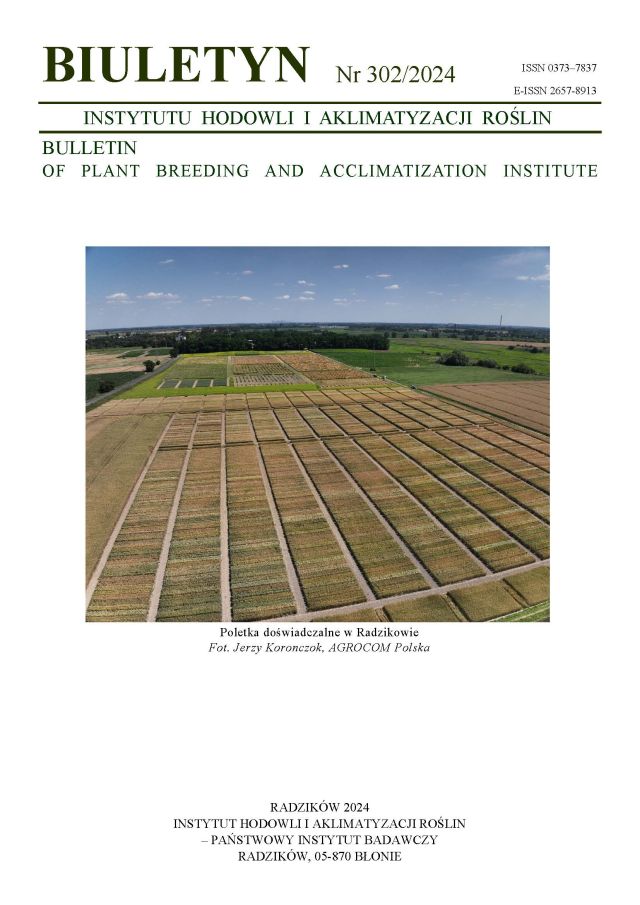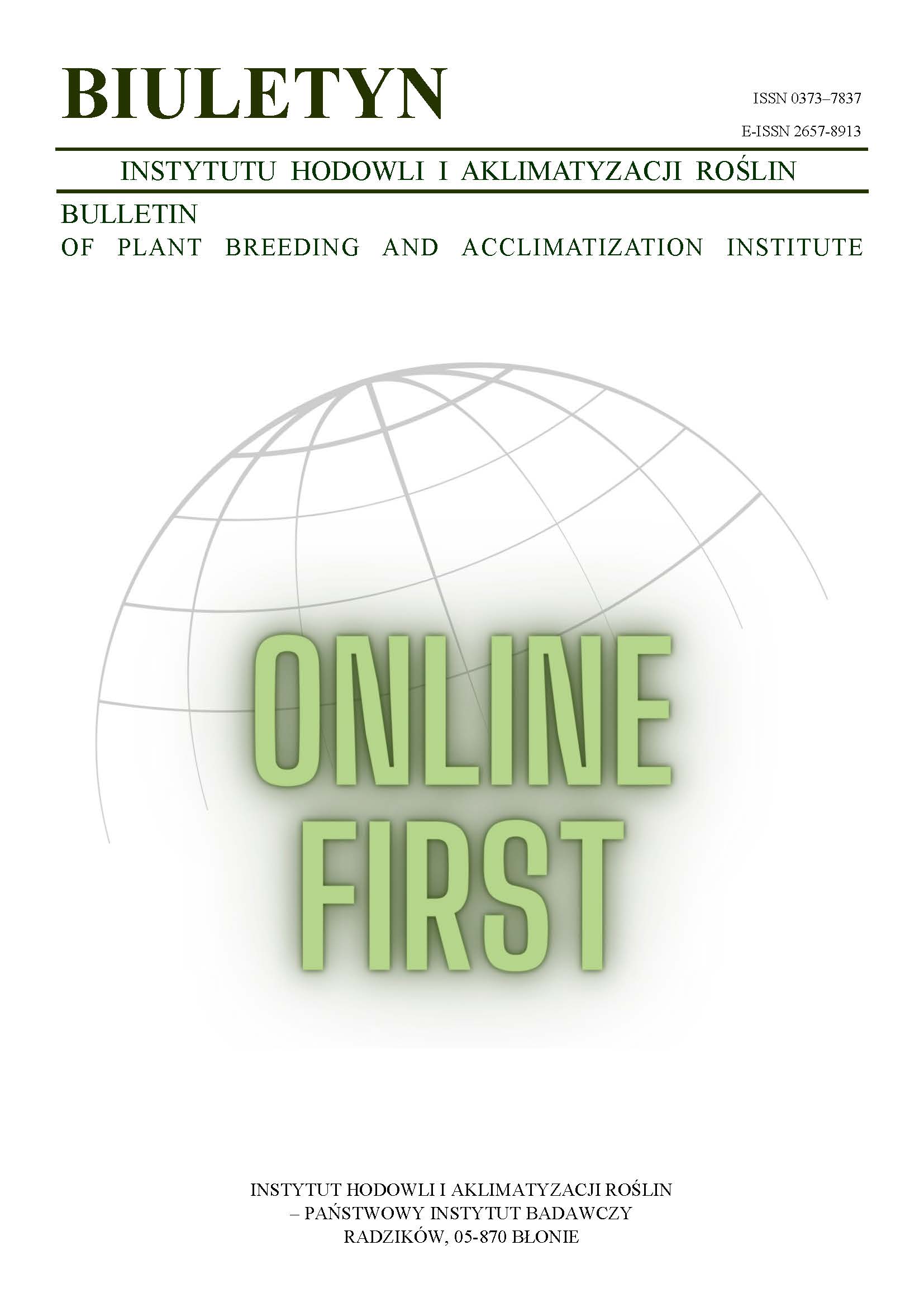Variation of anther development in individual plants of winter triticale with Triticum timopheevi cytoplasm
Halina Góral
kfhrin@urk.edu.plKatedra Hodowli Roślin i Nasiennictwa, Akademia Rolnicza, Kraków (Poland)
Grzegorz Jagodziński
Katedra Hodowli Roślin i Nasiennictwa, Akademia Rolnicza, Kraków (Poland)
Abstract
Winter triticale anthers were evaluated in F2 plants obtained by crossing male sterile line Salvo 15/1, with fertility restoring line Bogo 5/3. The anthers were scored using a 5 grade scale. The results showed a varying degree of anther development among plants, ears, sides of ear, spikelets in ear and flowers in spikelet. The highest variation was observed among spikelets (28.75%) and anthers in flowers (21.25%). The anthers in apical spikelets were deformed more than those in the middle and basal parts of the ear.
Supporting Agencies
Keywords:
anther development, male sterility, winter triticaleReferences
Bartkowiak-Broda I., Popławska W., Liersch A., Gazecka B. 1996. Badania nad genowo-cytoplazmatyczną niepłodnością typu CMS pol u rzepaku ozimego. Rośliny Oleiste, XVII: 21 — 32.
Google Scholar
Geiger H. H., Miedaner T. 1996. Genetic basis and phenotypic stability of male fertility restoration in rye. Vortr. Pflanzenzüchtg. 35: 27 — 38.
Google Scholar
Geiger H. H., Yuan Y., Miedaner T., Wilde P. 1995. Environmental sensitivity of cytoplasmic genic male sterility (CMS) in Secale cereale L. In: Genetic Mechanisms for Hybrid Breeding. Eds. U. Kück, G. Wricke. Adv. Plant Breed. 18: 7 — 17.
Google Scholar
Góral H. 2002. Ocena męskiej płodności mieszańców F1 pszenżyta ozimego z cytoplazmą Triticum timopheevi. Folia Univ. Agric. Stetin., Agricultura 228 (91): 17 — 22.
Google Scholar
Łapiński M. 1977. Genowa i cytoplazmatyczna męska niepłodność u żyta (Secale spp.). Rozprawy, Akademia Rolnicza w Szczecinie, 49.
Google Scholar
Mihaljev I. 1976. The influence of some factors on the fertility restoration in cytoplasmic male sterile wheat lines. Poljoprivredna Znanstvena Smotra, 38 (48): 79 — 84.
Google Scholar
Sage G. C. M. 1972. The inheritance of fertility restoration in male sterile wheat carrying cytoplasm derived from Triticum timopheevi. Theor. Appl. Genet. 42: 233 — 243.
DOI: https://doi.org/10.1007/BF00277550
Google Scholar
Scoles G. J., Evans L. E. 1979. The genetics of fertility restoration in cytoplasmic male-sterile rye. Can. J. Genet. Cytol. 21: 417 — 422.
DOI: https://doi.org/10.1139/g79-045
Google Scholar
Warzecha R., Salak-Warzecha K. 2002. Hybrid triticale — prospects for research and breeding — Part II: Development of male sterile lines. In: Proc. 5th Int. Triticale Symp., IHAR Radzików, Poland, 30 June 5 July 2002, vol. I: 193 — 198.
Google Scholar
Authors
Halina Góralkfhrin@urk.edu.pl
Katedra Hodowli Roślin i Nasiennictwa, Akademia Rolnicza, Kraków Poland
Authors
Grzegorz JagodzińskiKatedra Hodowli Roślin i Nasiennictwa, Akademia Rolnicza, Kraków Poland
Statistics
Abstract views: 89PDF downloads: 24
License
Copyright (c) 2005 Halina Góral, Grzegorz Jagodziński

This work is licensed under a Creative Commons Attribution-ShareAlike 4.0 International License.
Upon submitting the article, the Authors grant the Publisher a non-exclusive and free license to use the article for an indefinite period of time throughout the world in the following fields of use:
- Production and reproduction of copies of the article using a specific technique, including printing and digital technology.
- Placing on the market, lending or renting the original or copies of the article.
- Public performance, exhibition, display, reproduction, broadcasting and re-broadcasting, as well as making the article publicly available in such a way that everyone can access it at a place and time of their choice.
- Including the article in a collective work.
- Uploading an article in electronic form to electronic platforms or otherwise introducing an article in electronic form to the Internet or other network.
- Dissemination of the article in electronic form on the Internet or other network, in collective work as well as independently.
- Making the article available in an electronic version in such a way that everyone can access it at a place and time of their choice, in particular via the Internet.
Authors by sending a request for publication:
- They consent to the publication of the article in the journal,
- They agree to give the publication a DOI (Digital Object Identifier),
- They undertake to comply with the publishing house's code of ethics in accordance with the guidelines of the Committee on Publication Ethics (COPE), (http://ihar.edu.pl/biblioteka_i_wydawnictwa.php),
- They consent to the articles being made available in electronic form under the CC BY-SA 4.0 license, in open access,
- They agree to send article metadata to commercial and non-commercial journal indexing databases.
Most read articles by the same author(s)
- Stefan Stojałowski , Marta Orłowska , Martyna Sobczyk , Anna Bienias , Marcin Berdzik , Beata Myśków , Halina Góral , Magdalena Simlat , Tomasz Warzecha , Wojciech Wesołowski , Marek Szklarczyk , Mirosław Pojmaj , Genetic background of male sterility in triticale with different cytoplasm’s and perspectives of it utilization for development of CMS system in wheat , Bulletin of Plant Breeding and Acclimatization Institute: No. 286 (2019): Special issue
- Halina Góral, Male fertility of winter triticale depending on the cytoplasm and male parent , Bulletin of Plant Breeding and Acclimatization Institute: No. 269 (2013): Regular issue
- Halina Góral, Maciej Ejsmond, Combining ability analysis and heritability of yield components in linseed (Linum usitatissimum L.) , Bulletin of Plant Breeding and Acclimatization Institute: No. 249 (2008): Regular issue
- Halina Góral, Mirosław Pojmaj, Renata Pojmaj, Monika Burczy, Production of hybrid seeds of winter triticale from cms and restoring lines in strip and bulk sowing , Bulletin of Plant Breeding and Acclimatization Institute: No. 252 (2009): Regular issue
- Halina Góral, Mirosław Pojmaj, Renata Pojmaj, Frequency of maintainer and restorer genotypes for the cms-T. timopheevi system winter triticale , Bulletin of Plant Breeding and Acclimatization Institute: No. 244 (2007): Regular issue
- Elżbieta Pisulewska, Julita Maciejewicz-Ryś, Halina Góral, Yield, chemical composition and protein quality in long flower head forms of red clover (Trifolium pratense L.) , Bulletin of Plant Breeding and Acclimatization Institute: No. 228 (2003): Regular issue
- Tomasz Warzecha, Halina Góral, Susceptibility of auto- and alloplasmic triticale lines to seedling blight caused by Fusarium culmorum (W.G.Sm.) Sacc. , Bulletin of Plant Breeding and Acclimatization Institute: No. 236 (2005): Regular issue
- Halina Góral, Jadwiga Przypadek, Ludwik Spiss, Selection of red clover (Trifolium pratense L.) with regard to length and number of flower heads , Bulletin of Plant Breeding and Acclimatization Institute: No. 226/227 (2003): Regular issue
- Halina Góral, Ludwik Spiss, Development of maintainer and restorer genotypes for cms-T. timopheevi system in spring triticale , Bulletin of Plant Breeding and Acclimatization Institute: No. 236 (2005): Regular issue
- Tomasz Warzecha, Halina Góral, Combining ability of cms lines, strains and cultivars of triticale for susceptibility to seedling blight caused by Fusarium culmorum , Bulletin of Plant Breeding and Acclimatization Institute: No. 240/241 (2006): Regular issue














